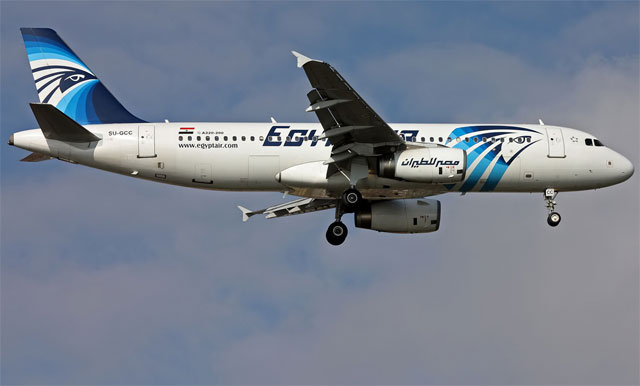My Airliners.net colleague, Mr. FlyingTurtle is always kind enough to post periodic synopsis of accidents in order to keep discussions there not going too far astray. He has given permission for the synopsis to be put on the GerryAirways website.
Background
- 66 people were on board. None of the people on the manifest were on a terrorism watchlist.
- Leaked passenger list: According to a leaked passenger list, only very few of the passengers have a non-Arabic name. A leaked passenger list can be found on a anti-Muslim website http://www.shoebat.com
- Strangely, the plane mentioned on the leaked crew list is SU–GBZ, but at least two confirmed victims (among them, French photographer Pascal Hess) do appear on the passenger list.
- Earlier that day, SU-GCC flew to Asmara (Eritrea) and Tunis, returning to Cairo each time.
- According to BBC, no terrorist organization has credibly claimed responsibility.
Flight History
- Flight entered Athens FIR at 2:24 AM. Last successful communication was at 2:48, the flight was cleared to the exit of Athens FIR. “The pilot was jocund and thanked in Greek.”
- Several ACARS messages beginning at 3:26 AM:
– 00:26Z 3044 ANTI ICE R WINDOW
– 00:26Z 561200 R SLIDING WINDOW SENSOR
– 00:26Z 2600 SMOKE LAVATORY SMOKE - At 3:27, Athens Area Control Center (ACC) tried to communicate with the flight, to hand it over to the Cairo FIR. Repeated calls, also on the emergency frequency, went without any response. At the same time, 0:27Z, there was the “2600 AVIONICS SMOKE ACARS” message.
- ACARS message:
– 00:28Z 561100 R FIXED WINDOW SENSOR - The flight passed the FIR boundary at 3:29 AM. At the same time, these ACARS messages were sent:
– 00:29Z 2200 AUTO FLT FCU 2 FAULT
– 00:29Z 2700 F/CTL SEC 3 FAULT
– After those, no more ACARS messages were received. - At 3:29:40 AM, the flight was lost from ATC radar, almost 7 nm southeast of KUMBI (KUMBI lies on the FIR boundary). The civilian ATC radar track shows that the plane never departed FL370.
- The Greek Air Force was called, they were unable to track the plane with their radars (as it had already crashed at this time).
- Supposedly, the Greek Air Force’s primary radars did record the plane’s flight. “It turned 90 degrees left and then a 360-degree turn toward the right, dropping from 37,000 to 15,000 feet and then it was lost at about 10,000 feet.” (Paul Kammenos, Greek minister of defense)
Search
- First debris spotted at around noon of May 20th, about 290 km north of Alexandria. Among the first objects found are seats, luggage and body parts.
- Possible oil slick photographed by the European Space Agency’s Sentinel satellite.
Possible Explanations
- The crew did not respond to repeated calls by Athens ACC, yet the flight didn’t disappear from radar until a few minutes later. This suggests the crew was either incapacitated or unable to respond due to an emergency.
- The time span between the attempted calls by Athens ACC and the disappearance rules out an explosive event that would have totally crippled the plane.
- An on-board fire.
What can be reasonably ruled out?
- A struggle in the cockpit, including a hijacking.
- A bomb that led to a decompression (though not an incendiary device).
- Helios-type of accident (crew incapacitation due to asphyxiation) is improbable, as the plane would have simply continued the flight.
The synopsis is posted for readers to be able to keep track of developments on the accident, and be up to date with regards to discussions flows among serious enthusiasts and knowledge-sharing professionals.


because of the dedication to facts and the expertise displayed here, this is an excellent blog. It is also very user-friendly which non-experts like myself really appreciate. 🙂 Thanks to Gerry Soejatman and Mr Flying Turtle for providing this service.